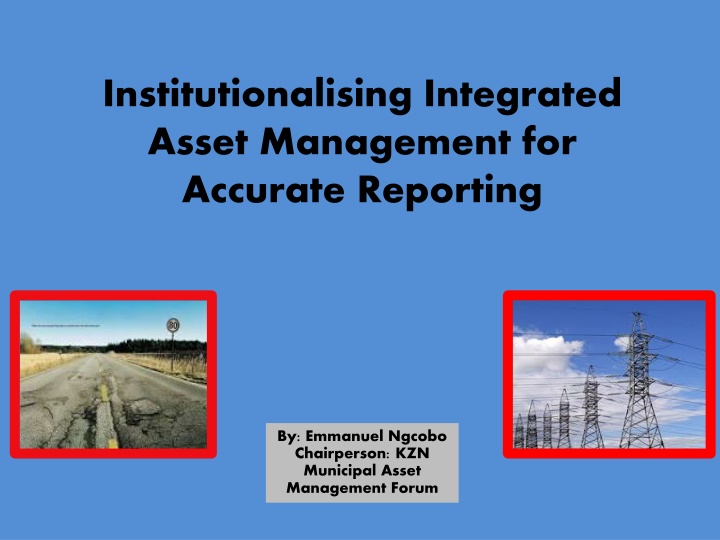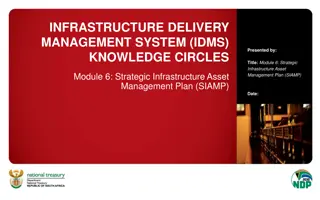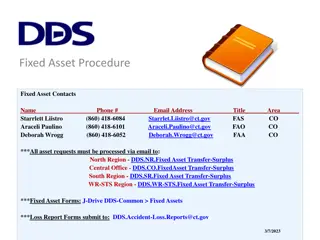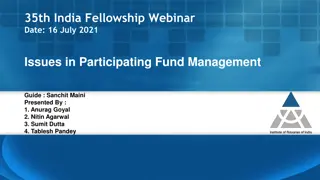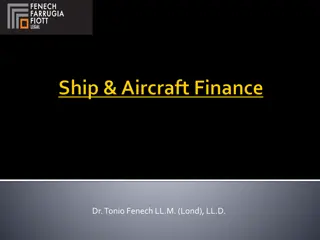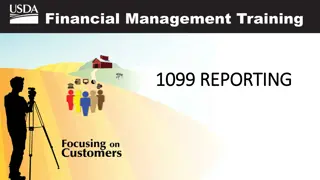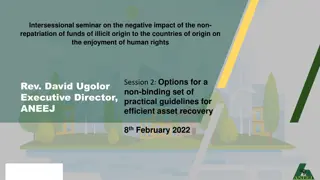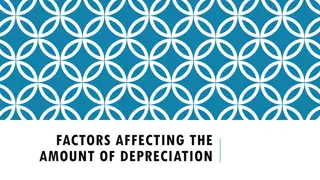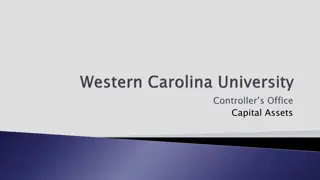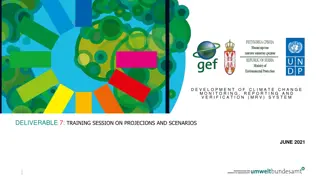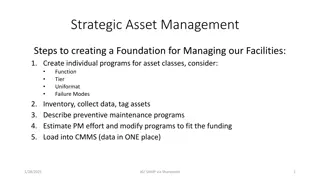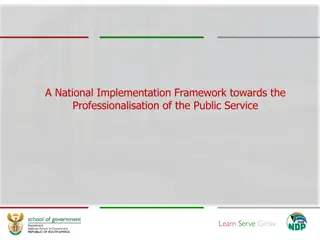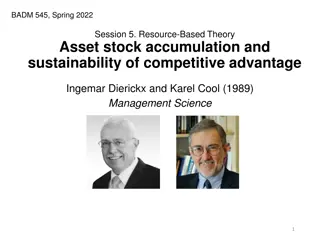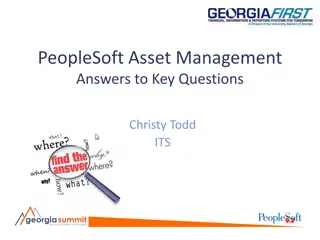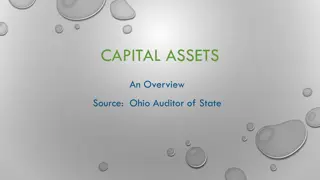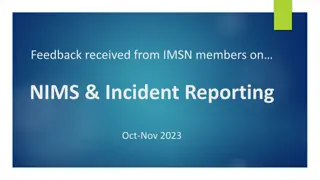Institutionalising Integrated Asset Management for Accurate Reporting
Municipal Asset Management practices encompass tagging assets, verifying asset conditions, tracking asset movements, disposal processes, updating asset registers, and more. The concept of Asset Management involves strategically acquiring, maintaining, upgrading, and disposing of assets cost-effectively, considering factors like scarce resources, critical assets, and risk assessments.
Uploaded on Mar 06, 2025 | 1 Views
Download Presentation

Please find below an Image/Link to download the presentation.
The content on the website is provided AS IS for your information and personal use only. It may not be sold, licensed, or shared on other websites without obtaining consent from the author.If you encounter any issues during the download, it is possible that the publisher has removed the file from their server.
You are allowed to download the files provided on this website for personal or commercial use, subject to the condition that they are used lawfully. All files are the property of their respective owners.
The content on the website is provided AS IS for your information and personal use only. It may not be sold, licensed, or shared on other websites without obtaining consent from the author.
E N D
Presentation Transcript
Institutionalising Integrated Asset Management for Accurate Reporting By: Emmanuel Ngcobo Chairperson: KZN Municipal Asset Management Forum
Municipal Asset Management Practises Tagging assets with Barcodes/Asset Numbers Verification of Assets (Good, Average, Poor) Tracking Movements of Assets (Locations) Asset Take-ons/Write-offs; Disposal Processes Updating Asset Registers with changes as per above Capitalisation of Completed Projects from WIP/AUC and Componentisation Calculation of Depreciation; Monthly Reconciliations AFS Disclosures (Note 10;11;12; Appendix B) The financial statements are free from material mis-statements (in other words, a financially unqualified audit opinion) and there are no material findings on reporting on performance objectives or non- compliance with legislation. CLEAN AUDIT OUTCOME
Asset Management Concept Asset management, broadly defined, refers to any system that monitors and maintains items of value to an entity or group. It may apply to both tangible assets such as buildings and to intangible concepts such as computer systems and software. This being a systematic process of acquiring, operating, maintaining, upgrading, and disposing of assets cost-effectively.
PLANNING Acquire COST EFFECTIVE VALUE CHAIN Dispose Maintain Value Assess
Asset Management Simplified Scarce Resources/Funding Constraints Critical/Strategic Assets Impact of Failure Prioritise Higher Revenue Generating Assets Strategically located Assets Tourism Nodes/Areas Industrial Areas (*loss of jobs/businesses) Sensitive Areas . RISK ASSESSMENT
Asset Management Concept Acquisition:- > IDP Alignment > Master Plans > Budget/SDBIP Stages > Procurement Plans > Bid Committees (BSC) Recording:- > As-Builts Drawings > Warranties/Guarantees > GIS Information Operating and Maintenance/Monitoring:- > O & M Plans driven by conditional assessments as required by GRAP17 Disposals:- > Decommissioning (Regulations) > Attaining Best Possible value on Disposal
Acquire Dispose Maintain Value Assess Infrastructure Asset Management Plan Investment Plan IDP/Master Plan/ MTERF Budget Operations and Maintenance Plan
Asset Management Concept: Municipal Point of View To provide an agreed level of service in the most cost effective manner for present and future communities
Asset Management Concept: Detailed Point of View A strategic and integrated set of comprehensive processes (including management, financial, operating, maintenance and engineering) to gain lifetime effectiveness, return from physical assets and utilization while considering risks
Strategic Management Interrelation ships / Interdepend encies Socio- Economics Asset Long-Term Direction/ Sustainability Management Accounting (Service Delivery) Human capital (Skills) Engineering Information Technology
Municipal Asset Management Practises Tagging assets with Barcodes/Asset Numbers Verification of Assets (Good, Average, Poor) Tracking Movements of Assets (Locations) Asset Take-ons/Write-offs; Disposal Processes Updating Asset Registers with changes as per above Capitalisation of Completed Projects from WIP/AUC and Componentisation Calculation of Depreciation; Monthly Reconciliation AFS Disclosures (Note 10;11;12; Appendix B) The financial statements are free from material mis-statements (in other words, a financially unqualified audit opinion) and there are no material findings on reporting on performance objectives or non- compliance with legislation. CLEAN AUDIT OUTCOME
The Asset Management Strategy Outlines how the organisation s asset portfolio will support its service delivery Develops an asset portfolio to support service delivery Sets asset management priorities Undertakes gap analysis (available vs. required) Sets performance levels needed to achieve efficient service performance Provides the basis for the more detailed Asset Management Plan (Life-Cycle approach)
Practical Implementation Municipal Leadership buy-in & embrace of Asset Management Proper Asset Management Structure (and human resources) Defined municipal processes & procedures to ensure synergy & working relations for all stakeholders Proper IT Systems (Inclusive of GIS; O & M data recordings)
Benefits of an Integrated Strategic Asset Management Approach Asset reliability and uptime Maintaining maximum available capacity Maintaining security, worker & public safety (Reduced Risk Exposure) Avoidance of law suits and regulatory fines Eliminates/Minimizes higher cost of repairs and reactive maintenance (Higher returns on strategic assets) Sustainable provision of municipal services
MSCOA SEGMENT ADDRESS Funding Source of Income for Repairs & Maintenance Funding known upfront i.e. during planning phase Differentiating Opex/Capex at planning phase Function Recording standardisation/Uniformity of asset categories Item Asset/Expenditure Regional Indicator Where is this Assets/For which Community Classification Organisational/vote Project Operational/Capital - Links the Fixed Asset Register (FAR) automatically aligns with the IDP and MTREF Costing Item Impact on the Business (Tariffs/Cost Drivers)
mSCOA Asset Management System "Allows budgeting for ""new capital"" projects requested in the integrated development plan (IDP). "Anticipates completion and subsequent operational costs of these ""new capital"" projects. "Calculates existing and anticipates new planned assets' maintenance, insurance and a percentage of ""un- planned"" maintenance. "Calculates depreciation, taking into account the impact of major repairs. "Calculates profit or loss on planned disposals.
mSCOA Asset Management "Provides for a (contract) retention payment schedule. "Provides for grant and work-in-progress (WIP) or contract management payment schedules to assist the main budget module with its forecasting and cash flow management. "Supplies the general ledger's main budget module planned budgets with the full mSCOA segments as a budget line. This functionality should be able to provide this for both expenditure and balance sheet items. "Provide the asset maintenance plan."
Leaders are Visionaries Asset Managers think for Future Communities Asset Managers are Leaders Do Your Part ..www.municipalassets.co.za .
